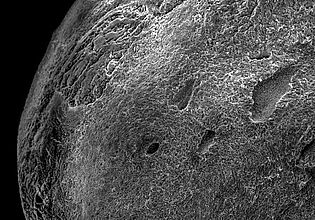News | Thursday, 11 May 2023
How does the human brain work? Leopoldina publishes statement on brain organoid research

Image: Katherina Psathaki and Thomas Rauen
Brain organoids are tissue structures created in the lab, which imitate certain functions of the brain. As a simplified model system, they enable experimental access to questions surrounding the development and function of the human brain. In the statement “Brain organoids – model systems of the human brain”, published today by the German National Academy of Sciences Leopoldina, scientists examine the opportunities to be found in this research area and whether it should be more strictly regulated for ethical or legal reasons.
Organoids are tissue structures derived from stem cells, which grow three-dimensionally in vitro, i.e., outside the human body, and imitate the cellular architecture and specific functional aspects of an organ. Just like the human brain, brain organoids consist of nerve cells and glial cells that form supportive and protective tissue.
“Brain organoids provide new insights into early brain development and the development of neurological and psychiatric diseases. They also enable study of the effects of drugs, toxins, germs or viruses on human brain cells and on brain development,” says Hans Schöler, Director of the Department of Cell and Developmental Biology at the Max Planck Institute for Molecular Medicine Münster, Member of the Leopoldina, and a spokesperson of the working group behind the statement. The paper examines how research on and with brain organoids can enable a deeper understanding of individual processes of the human brain. In addition, the researchers explain how brain organoid research will examine application-focused questions, such as the creation of developmental disorders that may lead to neurological and psychiatric diseases, the mechanism of viral infections, and new insights into neurodegenerative processes.
At the same time, research on brain organoids raises various ethical and legal questions. For example, the question of whether or not to introduce an obligation to protect brain organoids has yet to be clarified. Most experts agree that any such right would only arise if brain organoids were to possess consciousness or sentience – a condition which the working group believes is not fulfilled. After all, brain organoids to date have not attained the density and complexity of human brains. In addition, the tissue structures lack “sensory impressions”. Sensitivity to pain, for example, is a complex process involving various areas of the brain. The statement rejects the proposition that highly developed brain organoids merit protective status similar to that of embryos. As brain organoids, unlike embryos, cannot develop into a whole organism or even a human being, similar protection to that provided for embryos in the German Embryo Protection Act cannot be derived from current law and is not constitutionally required.
The authors conclude that, in the foreseeable future, research on and with brain organoids in vitro will not raise any ethical or legal questions requiring regulation. However, current limits to the potential development of brain organoids could possibly be overcome in the future thanks to developments in this field of research. In this case, the researchers recommend that established procedures of self-regulation within the scientific community should be used to assess and react to ethically, legally or socially relevant developments in this field at an early stage.
The statement was developed by the interdisciplinary working group “Brain Organoids – Opportunities and Limitations”, and involved researchers from medicine, neuroscience, law, medical ethics, philosophy, and information science.
